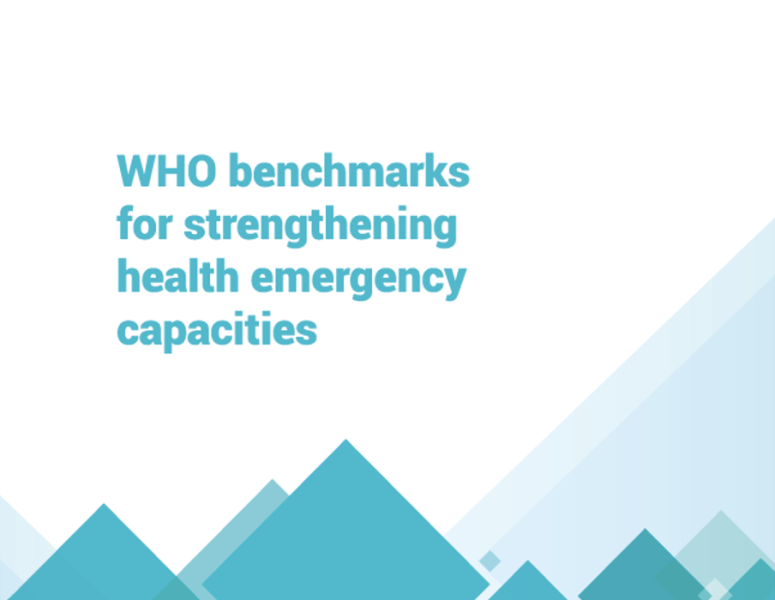
WHO launched the Benchmarks for Strengthening Health Emergency Capacities and Online Platform
WHO Benchmark Tool
WHO-HQ
On 19 April 2024, the World Health Organization (WHO) officially launched the WHO Benchmarks for Strengthening Health Emergency Capacities and accompanying digital platform. The benchmark tool provides a list of benchmarks that are required to sustain IHR and health emergency prevention, preparedness, response and resilience (HEPR) capacities and a list of actions that can increase IHR and HEPR capacities, with an aim to enhance health emergency capacities, through its utilization as a reference document, and benchmarking framework for capacity building and facilitating the development of plans around health security.
This release marks an evolution from the initial WHO Benchmarks for IHR Capacities (2005) published in 2019, and now updated incorporating lessons learnt from COVID-19 pandemic and other recent health emergencies, while ensuring alignments with the updated IHR monitoring and evaluation framework (IHRMEF) tools.

Dr. Stella Chungong, Director of the Health Security Preparedness Department at WHO, highlighted the importance of the benchmark tool during her remarks: "It is such a powerful tool which not only provides references, but also helps to build capacities with adaption of country context. It is used to guide, tailor, prioritize and inform better planning." Dr. Chungong also acknowledged the inputs from over 250 experts worldwide to the benchmark tool.
Dr. Nirmal Kandel, Head, Evidence and Analytics for Health Security unit at WHO, introduced the updating process and utilization of the tool, noting that the digital platform simplifies access to the Benchmarks, enabling users to tailor action plans based on evaluations and contexts. In addition, the benchmark tool supports the development of various national action plans including National Action Plans for Health Security (NAPHS), integrating a range of health threats and areas of disaster risk reduction.
Amanda McClelland, Senior Vice President, Resolve to Save Lives, chaired the panel discussion. She said the benchmark tool is a bridge “from Joint External Evaluation (JEE) to a dedicated NAPHS and supports Member States with prioritization and collaboration. It radically improves the time taken to create a quality action plan.”
Panel discussions during the launch emphasized practical applications of the benchmark tool across different regions. Dr. Reuben Samuel from the WHO Regional Office for South-East Asia shared insights on how the updated benchmarks recently facilitated swift and quality draft plans for health security in Sri Lanka and noted that the WHO benchmark tool has clearly facilitated the discussion among national experts and stakeholders as they seek to convert JEE recommendations into implementable actions at the strategic and operational level.
Dr. Savané Kroman from Cote D'Ivoire Ministry of Health, and Dr. Vida Mmbaga from Tanzania Ministry of Health discussed how the benchmark tool had been adapted and utilized effectively in their countries to facilitate the development of NAPHS. “It was used as a first step to clean up and harmonise the actions to be submitted to the national multisectoral technical experts for prioritisation of the NAPHs, and provides clarity on the comprehensiveness of interventions for each indicator/level to move from one score to the next,” said Dr. Kroman. Echoed by Dr. Mmbaga, that the benchmark tool brings efficiency in creating as well as monitoring the implementation of the plans, and was used to develop NAPHS, and Annual Interim Operation Plan (NIOP) for Health Security (2023-2024).
“The benchmark tool is an excellent example of one of the essential tools for countries to generate impact through monitoring, evaluation, learning, targeted setting, examining gaps,” stated Jennifer Lasley, Senior Programme Coordinator, World Organisation for Animal Health.
Michael Mahar, Associate Director for Global Health Security from US CDC stressed that the WHO benchmark tool is a critical part of IHRMEF that has already been used by US CDC. He said it allows Member States to prioritize work, move from IHR States Parties Self-Assessment Annual Report (SPAR) and JEE assessments to take actions, and do what needs to be done.
WHO acknowledges Resolve to Save lives and other partners for their invaluable and continuous support. WHO and its partners remain committed to strengthening global health security through collaborative efforts and shared knowledge, aiming for a safer and more resilient world in the face of emerging health threats.
WHO looks forward to the utilization of the WHO benchmark tool by Member States, with support of three levels of the Organization as well as partners and other agencies, and calls for submission of guidance, reference documents, and case studies to the reference library through the digital platform.